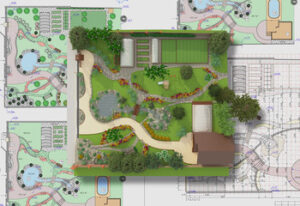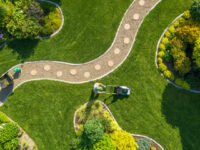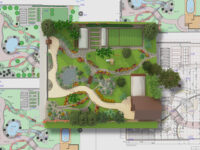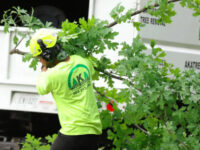Modern Trends In Landscape Design
The newest trends in Landscaping Harrisburg PA design are centered around sustainability and the obligation to develop outdoor retreats that benefit the environment. These ideas are designed to create beautiful and functional outdoor spaces that enhance the appeal of homes while helping to protect the planet.
 Minimalism is a popular style that leverages clean lines, monochromatic color schemes, and open spaces to foster tranquil simplicity. Entangled designs that blend the landscape with the hardscape are also in demand.
Minimalism is a popular style that leverages clean lines, monochromatic color schemes, and open spaces to foster tranquil simplicity. Entangled designs that blend the landscape with the hardscape are also in demand.
Minimalism
Minimalism has been a popular interior design trend for some time, and it’s starting to make its way into landscape design. This style focuses on simplicity and clean lines, often using a neutral color palette with a focus on negative space. This creates a more open and serene environment that’s easy to maintain.
Minimalism will continue to be one of the top modern trends in landscape design. This style emphasizes the use of natural materials and creates a connection between people and nature. It’s been shown that exposure to nature can reduce stress, boost creativity, and improve health. This is why it’s important to incorporate nature into your home and landscape designs.
Another aspect of minimalism is focusing on the use of geometric shapes and sticking to a few key plant species. For example, using a few well-placed evergreens and holly trees can add texture and drama to your design. These trees can also grow incredibly fast, which means you don’t have to spend as much time maintaining them.
Other minimalist elements include incorporating native plants and integrating biophilic features into your landscape design. This can be anything from a bird feeder to an outdoor seating area. It’s important to remember that landscape design is not a one-size-fits-all approach, so it’s essential to find a style that works for your lifestyle and needs.
A newer and more sustainable option is regenerative landscaping, which takes sustainability to the next level by incorporating practices like soil regeneration, carbon sequestration, and biodiversity restoration into your landscape design. This allows you to achieve a more balanced and healthy ecosystem that can thrive in a changing climate.
Regenerative Landscaping
A regenerative landscape is an ecologically active garden or yard that supports healthy landscapes, food security, and climate stability. This landscape design technique includes plantings, trees, water bodies, mulches, soil amendments, hardscapes (like stone & tile), and irrigation systems. It incorporates a wide range of creative techniques and methods to promote biodiversity, community connection, and sustainable practices in home gardens and public spaces.
Regenerative landscape designs are a newer trend, and they’re becoming increasingly popular due to the effects of climate change. They also provide a variety of benefits, including increased biodiversity and reduced carbon emissions. However, they can be a challenging undertaking for beginners because they often require a high level of expertise and knowledge to properly implement.
Despite the challenges, regenerative landscaping can be an excellent way to improve your home’s environmental footprint. The key is to focus on ecosystem health and balance, which is achieved by integrating native species that fit the local climate and soil conditions. This approach can also help reduce the amount of water used for lawn care and gardening, as well as enhance the overall aesthetic of the landscape.
Another important aspect of regenerative landscaping is working with edges and mosaics. This refers to the arrangement of different types of plants within a garden or yard, and it helps achieve greater overall productivity. This can include grassed areas, shrubs, water bodies, edibles, and even mature forests.
Another important feature of regenerative landscaping is incorporating the latest technological advancements. This can include outdoor heaters, phantom screens, wired speakers, and phone applications that allow homeowners to control their landscape lighting and music. These features can help homeowners save money on electricity and water usage while adding a unique, personalized touch to the home’s exterior.
Elementals
Landscape design encompasses the aesthetic and functional elements of a garden, yard, or courtyard. These elements may include plants, trees, grass, paving stones (like gravel and concrete), irrigation systems, and outdoor lighting. They can be used to create a cohesive space that is pleasing to the eye and welcoming to visitors. This trend continues to grow as more homeowners want their gardens and yards to be a relaxing, inviting living area.
This trend is also known as curated wilding or nature-scaping and involves creating an outdoor living space that looks like it has evolved naturally over time. It often incorporates local species and a mix of flowering plants and herbs for an organic, natural feel. Some designers even suggest using foliage plants to add texture and depth to a landscape. This way, the garden can still look vibrant even when the flowers aren’t in bloom.
Another trend that continues to grow is the use of vertical space for gardening. Living walls have become increasingly popular, and they can be made from a variety of materials, including stacked rocks and recycled materials. They are an excellent way to add greenery to a home, improve air quality, and reduce noise pollution.
This is also a trend that combines well with other sustainable landscaping practices. For example, you can pair a living wall with a rain garden or water feature to make the most of your space. This is also a great way to reduce the amount of water you need to maintain your landscape. Additionally, you can use a rain barrel to collect and store water for when droughts hit. You can then use that water to water your garden or even wash your car.
Naturalistic Design
Rather than boxy rows of hedges and manicured lawns, forward-thinking homeowners are pursuing landscape design trends that emphasize the natural world. This modern trend is called naturalistic design, and it’s a great way to add beauty to your yard while also making it more functional.
In a naturalistic garden, plants are grouped in proportionate layers to mimic the structure of wild landscapes. Perennials and grasses are freely intermingled, with one group flowing into and past another to create a more natural-looking planting.
This type of garden focuses on a more rustic aesthetic, including stone pathways, trellises, and rustic accents like old watering cans. This garden style is also popular for those looking to grow their vegetables and herbs.
As a result, more landscape architects are designing spaces that look and feel like nature. These gardens often include a variety of different textures and colors, as well as plants that attract wildlife to the space. Additionally, these designs feature more plant groupings and more focal points to create a sense of space and scale that is often missing in other types of gardens.
In addition, naturalistic gardens use native and low-water plants that are adapted to local climates and soil conditions. They also minimize typical garden inputs like pesticides and fertilizers while maximizing inputs such as rainwater and composted yard waste.
Finally, these gardens prioritize functions like food gardening, wildlife habitat, and biodiversity restoration. As more people focus on reconnecting with nature, this landscaping trend is expected to continue to gain popularity in 2023.
Microclimates & Microhabitats
A microclimate is an area of a landscape that has different conditions than the surrounding environment. These can include differences in air temperature, water availability, light exposure, or soil type. These different conditions create an environment that is either more or less hospitable to certain plants or wildlife.
Microclimates can play a major role in the survival of cold-blooded animals, especially small mammals and amphibians. Creating a diversity of microclimates in your yard can help reduce the risk of losing species as a result of climate change.
As part of the naturalistic design movement, more landscapes are being designed as meadows, incorporating native plants, and focusing on conservation. These landscapes also incorporate a more sustainable design by using less water and reducing the need for fertilizers.
Many homeowners are now seeking out landscape designers who specialize in ecological restoration and conservation, which is a more holistic approach to designing and maintaining a garden or yard. This includes using repurposed materials such as old bricks and stone to make features in the garden, and even incorporating unused household items into the landscape, like old bicycle wheels or metal planters.
Adding more texture to the landscape is another trend that’s becoming increasingly popular. This is accomplished through the use of grasses and succulents, which add a natural feel to the space. Many landscapers are incorporating these textures into their designs to create contrast and intrigue.
Functionality is also a growing concern for homeowners. People want their yards to be more than just an aesthetic space; they want to have a place where they can relax and enjoy time outdoors. This can be anything from a garden where they can grow their vegetables to a green space that supports biodiversity.





